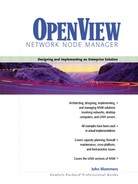Deciding What Devices to Export
In the previous section you saw a collection station export filter that defined only subnets and routers. The result is an Internet submap at the management station showing end-to-end connectivity in the IP sense. Subnets contain only routers and no segments, switches, bridges, or other network infrastructure. Since a large corporate network will contain hundreds of routers with thousands of interfaces and subnets, this is a sizable map. The NNM system performance may degrade if additional network devices are imported from the collection stations.
Regardless, local requirements may dictate that additional devices be visible at the collection station. A prerequisite is that the collection station discovery filter must also pass whatever devices a management station may wish to import. Whenever possible, collection stations should be configured identically to ensure consistency in the export process.
Some strategies for determining what devices to export to the management station are seen in Table 6-1.
| Object Type | Rationale, Repercussions, and Considerations |
|---|---|
| routers and subnets | The management station shows all routers on the Internet submap. It’s suited for solving end-to-end network problems. |
| servers, printers, subnets, and segments | Subnets contain server and network printer icons inside their proper segments, and the subnets connectivity isn’t visible at all. |
| routers, switches, bridges, hubs, and subnets | The entire corporate network infrastructure is exported to the management station. The database is potentially huge, so the NNM system must be sized accordingly. |
To configure an export filter you have to know a well-defined consistent attribute that uniquely identifies a device. The OID is fairly unique, as is the IP address and device selection name. The vendor name may be too broad. For example, a vendor name of Cisco would pass any product the company manufactures. This would include any workstation or server with an adapter made by Cisco. There are also a large number of standard attributes such as isRouter, isInterface, and isHub. To determine an object’s properties (such as sysObjectID), right-click its icon to get the pop-up menu and choose the “Describe/ Modify Object” menu item.
